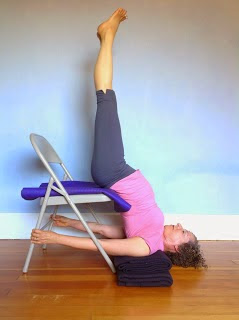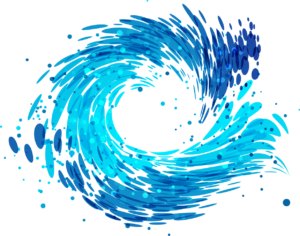by Nina

Although you might think of an “inverted” yoga pose as one where you are completely upside down, such as Handstand, Headstand, and Shoulderstand, any yoga pose where your heart is higher than your head is considered an inverted pose. That means there are three basic types of inversions:
- Full inversions, where your whole body is completely inverted, as in Headstand.
- Partial inversions, where your heart is directly above your head (or almost) but only part of your body is inverted, as in Standing Forward Bend (Uttanasana), Wide-Legged Forward Bend (Prasarita Padottanasana), and Plow pose.
- Gentle inversions, where your heart is only slightly above your head, as in Bridge pose, Downward-Facing Dog pose, and Legs Up the Wall pose.
The reason we group all these poses together is that any pose where your heart is higher than your head has a special quieting effect on your nervous system, which makes the poses especially calming (assuming you are comfortable in the pose, of course). You can find out why this happens in my post Why You Should Love Your Baroreceptors They are also good for heart health and circulation as gravity helps return venous fluids back to your heart (see Appreciating Your Entire Cardiovascular System).
Personally, I love all these poses and have found practicing them very beneficial for times when I’m feeling stressed. And because these poses are also beneficial for circulation, especially when your legs are inverted, I’ve been practicing them regularly for my varicose veins.
However, some of the full inverted poses, such as Headstand and Shoulderstand, can pose risks for certain people. And not everyone should be practicing poses that affect their blood pressure (which inversions do). Don’t panic, however, as you’ll find that most people can safely do the gentle inversions, no matter what. Fortunately, we have a lot of information on our blog on the benefits of these poses, how to practice them, and safety issues related to them.
First, I’ll start with background information about the poses themselves. Maybe this will help you discover some new ways to reduce your stress! Then I’ll provide links to the articles on inverted poses and sequences that utilize them. Finally, I’ll conclude with posts about cautions and safety issues for practicing them.
About Inverted Poses
In Just in Time for the Holidays I discuss the value of practicing inverted poses and why I’m such a fan of them.
In Why You Should Love Your Baroreceptors I provide the anatomical/medical background that explains exactly why inverted poses can be so calming for your nervous system.
In Techniques for Improving Cardiovascular and Heart Health Baxter and I provide tips for using inverted poses for heart and cardiovascular health.
In All About Supported Inversions I discuss the value of practicing the supported versions of all the inverted poses and provide photos and descriptions of all of them.
In Low Pressure Tactics Victor describes how he practiced inverted poses, among other things, to help lower his blood pressure.
Practicing Inverted Poses
Because we don’t want to instruct people via writing about how to practice full Headstand, Shoulderstand, and Plow pose, we don’t have information on how to practice those on our poses on our blog. For instructions, you should consult an experienced teacher who can teach you in person. However, we do have information on the supported versions of Shoulderstand and Plow. Here are the posts that describe how to do individual poses:
Featured Pose: Downward-Facing Dog Pose (For Downward-Facing Dog pose with head support, see Featured Sequence: Easy Supported Inverted Practice.)
Featured Pose: Standing Forward Bend
Featured Pose: Wide-Legged Forward Bend
Featured Pose: Chair Shoulderstand
Featured Pose: Legs Up the Wall Pose
Featured Pose: Easy Inverted Pose
Here are two sequences that use inverted poses:
Featured Sequence: Easy Supported Inverted Practice
Featured Sequence: Inverted Heart Health Practice
See All About Supported Inversions for recommendations on how to sequence inverted poses.
Safety and Inverted Poses
In Friday Q&A: Caution for Inversions I provide information about who should not be practicing which inverted poses or who should approach them with caution.
In How to Stay Safe While Practicing Yoga I provide generally information about staying safe while practicing yoga, all of which applies to the inverted poses.
In the following posts, Baxter addresses safety issues related specifically to Headstand:
Friday Q&A: The Safety of Headstand (Sirsasana)
Friday Q&A: Ostepenia of the Spine and Headstand
Friday Q&A: Implantable Cardioverter Defibrillators (ICD) and Yoga
Follow Yoga for Healthy Aging on Facebook ° To order Yoga for Healthy Aging: A Guide to Lifelong Well-Being, go to Amazon, Shambhala, Indie Bound or your local bookstore.


Hai, I am a student of human physiology and a yoga practitioner. Often my yoga teacher comes up with phrases that mean nothing to me. For example she says rest on your sit bones. There are no sit bones, the ischial tuberosity is part of the complete ischium and not a separate bone. She talks about keeping the spine straight, when in fact we know that the spine is naturally curved. Last week, she mentioned that inversions were great as gravity facilitates increased cerebral blood flow. Now in this article you addressed similarly by saying that "gravity helps return venous fluids back to your heart". How is that possible? The living body is not a huge jar of fluid for the fluid to flow out when inverted. If Gravity facilitated flow of body fluids, why are we not seeing an accumulation of body fluids in our legs, toes and feet? After all, we are bipeds and are most of the time standing. But we don't see fluid settling in the feet due to homeostatic mechanism. Am I missing something?
You actually are missing something. People often DO have problems with fluid settling in in their legs and feet. That is what varicose veins in the legs are and also people do get swollen ankles, etc. That's because while the heart pumps blood OUT to the extremities, veins are not as thick as the arteries and rely somewhat on physical activity to contract and relax the muscles they pass through and between to squeezes blood back to the heart. And this can become more problematic as we age. So active asanas and inverted poses can assist with the efficient return of blood to the heart. If you are interested in learning more about this, you should take some more time to study the circulatory system. I will ask Baxter to reply to you about this as well.